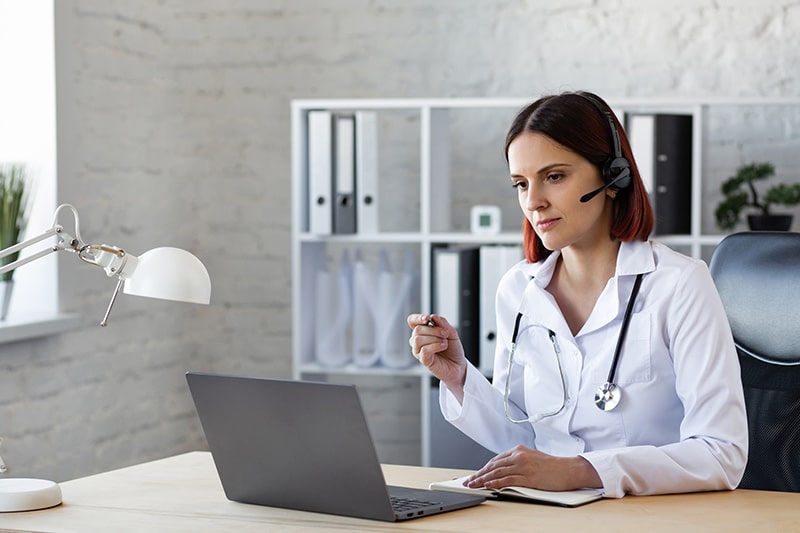
Remote patient monitoring (RPM), a subset of telehealth, allows healthcare providers to leverage technologies to deliver care to patients in their homes. In RPM, wired or wireless peripheral measurement devices such as glucometers, implantables, biosensors, blood pressure cuffs, and pulse oximetry to track and transmit patients’ healthcare data to their physician. RPM is used to monitor health conditions such as diabetes, health disease, blood pressure, weight gain/loss, dementia and substance abuse. Monitoring of vital signs alerts physicians of any problems and enable them to work with patients to manage their condition. Telehealth encounters are recorded using medical transcription services.
RPM offers many benefits for patients as well as healthcare organizations:
- Improves care quality and clinical outcomes
- Enhances efficiency and reduces costs
- Decreases chances of readmission
- Puts patients at ease – they can recover in the comfort of their homes, surrounded by their family
- Provides patients more control over personal health
- Boosts patient follow-through
- Home health addresses geographical barriers
- Can free up inpatient capacity during a public health emergency like the current pandemic by moving all patients home if they don’t have to be in the hospital
However, experts point out that to successfully implement RPM and leverage these benefits, providers need to focus on avoiding certain pitfalls.
- Suboptimal Resource Allocation: Optimal resourcing is crucial to ensure alignment among all stakeholders – leaders, administrators and technicians as well as among the doctors, clinicians, nurses and caregivers who are actively involved in the program on a daily basis. In a Care Innovations report, an expert describes lack of focused resourcing as “the number one risk facing a remote patient monitoring implementation.”
- Too many Interfaces: A recent HIT Consultant article reports RPM implementation will not work if patients have “too many disparate places that track their health”. Ensuring that all of the patient’s health information is centralized is crucial to make digital care more accessible and easier to understand. The ideal option would be set up a single app for the patient and integrate their RPM data on it. This will empower patients to actively participate in the managing chronic conditions and improve the overall digital health experience. Likewise, care teams should have all patient information consolidated on one dashboard.
Technology can also improve the overall telehealth experience. A secure online portal would serve as a single point of communication and allow patients to communicate with their healthcare provider including specialists, request prescription refills, schedule appointments, review test results and records of previous visits, and so on.
- Not Educating Patients on how RPM Works: Enrolling the right patients in the program and making sure they understand how the program works and what to expect is essential to RPM success. Providers need to take time to educate and train patients on using the technology and make them comfortable with it. The program should include a touchpoint that patients can use to ask for clarification if they don’t understand something.
- The Technology is Hard to Use: Patients won’t use the technology if it is difficult for them to track their health. Giving patients the option to sync their biometric devices with the health management platform will simplify data collection and also allow them to track their health easily. The app they are using must be able to display their RPM data clearly and logically. Patient engagement with digital health tools on a daily basis can be promoted in various ways such as creating medication reminders and making useful content available to help them manage their health. Presenting data visually as graphs or diagrams will help patients and providers recognize trends and take action.
Mobile-enabled RPM is a popular option for its ease of use by both patients and physicians. notifications to prompt patients to enter important data and once the data has been received, the physician can access and analyze the information to decide on whether the condition can be managed remotely or whether it calls for a face-to-face encounter.
The Centers for Medicare & Medicaid Services (CMS) has taken steps to improve reimbursement for RPM. According to a new survey by MSI International, patients are in favor of RPM, especially for monitoring of chronic diseases. About half want to see it integrated with clinical care services (mhealthintelligence.com), but expressed concerns about the accuracy of the technology and complications caused by the device used. Educating patients on monitoring their health using digital technology and ensuring the physicians can use patient data meaningfully is key to the success of RPM. Integration of the RPM platform with the EHR (electronic health record) allows providers to enter data directly into the medical record and access information needed for care management. With the rising demand for telehealth services and RPM, medical transcription outsourcing is a practical solution for healthcare providers to manage their EHR data entry tasks.


